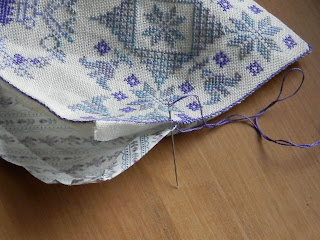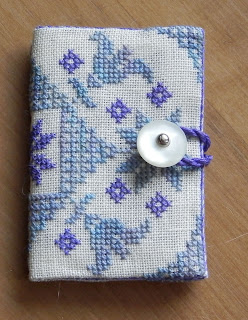Méthode avec tissu assorti sur le coté dos
Method with assorted fabric on back side
Methode met bijpassende stof op achterkant

Brodez le motif selon la grille, les piqures du bord inclus. Coupez avec environ 1 cm de marge autour du cadre. Coupez un carree de tissu du meme taille que le motif plus environ 1 cm.
Stitch
the motif according to the design, including the
stitching around the whole motif. Cut around the square leaving 1 cm of margin on the outside for the assembly. Cut a square of fabric the same size as the stitched square plus 1 cm.
Borduur het hele motief zoals aangegeven op het patroon, evenals de steken rondom het gehele motief. Knip ze uit met een rand van
ongeveer 1 cm voor het inelkaar zetten. Knip ook een vierkant uit stof met dezelfde grootte als het motief plus ongeveer 1 cm.
Pliez les rebords autour du motif le long de la ligne et marquer le pli. Pliez les rebords du tissu assorti egalement jusqu'a il a la meme taille que le carree brodee.
Fold the borders around the design along the line and mark them. Fold the borders of the assorted fabric as well until it has the same size as the embroidered square.
Vouw de randjes om rond het motief langs de lijn en strijk ze. Vouw de randen van de bijpassende stof ook om tot het dezelfde grootte heeft als het geborduurde vierkant.
Avec un épingle, repérez le milieu d'un des cotés du motif recto.
Préparez une aiguillée de fil avec 1 ou 2 brins. Faire un nœud au bout du fil.
With a pin mark the center of one of the sides on the front side of the motif.
Prepare a needle with 1 or 2 strands of thread. Make a knot at the end.
Markeer met een speld het midden van een van de zijden van de bovenkant van het motief.
Zorg dat je een naald hebt met 1 of 2 draden. Maak een knoopje aan het uiteinde.
Réalisez un point pour assembler un coin du motif verso au milieu du motif recto ( l'emplacement de l'épingle)
Make a first stitch to assemble the corner of the back side to the middle of the front side (where the pin is placed)
Maak een eerste steek om de hoek van de achterkant vast te maken in het midden van de voorkant (waar de speld zit)
Assemblez
les rebords des 2 carrés en passant votre aiguille, de haut en bas, par
dessous puis par dessus les points de piqûres.
Réalisez de petits points, une cote par passer travers la toile et l'autre cote par passer en dessous de la piqure du cadre, en gardant une tension dans le fil sans pour autant trop le tendre.
Assemble
the 2 squares by passing the needle down, under the stitch, through the fabric and then
over to the next stitches. Make these stitches while going
through the fabric on one side and going under the borderstitch on the other side, while keeping some tension on the thread, but not too
much.
Naai
de 2 vierkanten samen door de naald van boven naar beneden onder de
randsteek en door de stof steken en vervolgens over die steken naar de andere kant te
bewegen. Maak deze steken door aan de ene kant door de stof te steken en aan de andere kant onder de randsteek te gaan, terwijl je
spanning op de draad houdt, maar niet teveel.
Poursuivre
l'angle et continuez d'assembler les 2 carrees. Progressivement
l'ouvrage prend la forme du biscornu, un petit coussin avec 8 angles.
Continue
in the corners and go on to stitch the 2 squares together.While doing
this, it will more and more look like a biscornu, a little cushion with 8
corners.
Ga door in de hoeken en blijf de 2 vierkanten samen naaien. Terwijl je dit doet gaat het steeds meer op een
biscornu lijken, een kussentje met 8 hoeken.
Interrompez la couture après le 6ème ou 7ème cote, vous de décider. Il vous faut une ouverture suffisante pour ajouter le bourrage.
Stop stitching after the 6th or 7th corner, you decide. You'll need an opening ample enough for filling.
Stop
het samen naaien na de 6e of 7e hoek, dat mage je zelf beslissen. Je
hebt een opening nodig die groot genoeg is om te vullen.
Après avoir inséré le bourrage, complétez la couture pour fermer entièrement le biscornu. Passez votre aiguille travers le biscornu et réalisez un noeud pour bloquer le fil. Ne laissez pas de fil visible.
After
putting the filling in, finish stitching by closing the biscornu
completely. Put your needle a little way through the biscornu and make a
knot. Don't leave any visible thread.
Nadat
de vulling erin is gedaan, kun je doorgaan met dichtnaaien tot de
biscornu geheel gesloten is. Maak een knoopje aan het einde en werk deze
onzichtbaar weg. Laat geen draadje zichtbaar uitsteken.
 Choisissez 2 boutons assortis votre broderie. Fixez les boutons en les cousant au centre de chaque face, en passant votre aiguille travers le biscornu, d'un bouton l'autre, avec un fil bien tendu.
Choisissez 2 boutons assortis votre broderie. Fixez les boutons en les cousant au centre de chaque face, en passant votre aiguille travers le biscornu, d'un bouton l'autre, avec un fil bien tendu.
Choose
2 buttons fitting you stitching. Fix them by stitching them in the
middle of each square, threading your needle all the way through the
biscornu from one button to the next with a thread under a lot of
tension.
Kies 2
knopen die bij het borduurwerk passen. Maak ze in het midden van ieder
vierkantje vast, door de naald helemaal door de biscornu te steken van
een knoop naar de andere, met een draad met veel spanning erop.
Voila, un autre biscornu!
And look, an other biscornu!
Kijk, nog een biscornu!
 Commence par suivre les premiers stages de l'assemblage comme pour le biscornu 15 faces jusqu’à l'obtention du stage avec 10 carrés assemblés et 5 carrés assemblés. Si tu veux pendre ta biscofleur, il faut attacher une corde maintenant.
Commence par suivre les premiers stages de l'assemblage comme pour le biscornu 15 faces jusqu’à l'obtention du stage avec 10 carrés assemblés et 5 carrés assemblés. Si tu veux pendre ta biscofleur, il faut attacher une corde maintenant.

















































